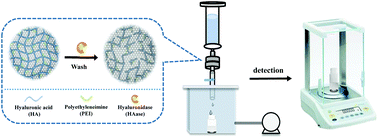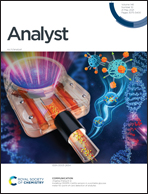Convenient hyaluronidase biosensors based on the target-trigger enhancing of the permeability of a membrane using an electronic balance as a readout†
Abstract
The change in hyaluronidase (HAase) is related to specific changes in the structure of vitreous, and it is necessary to develop simple but sensitive methods for HAase detection. In this work, a thin film fabricated from a hyaluronic acid (HA)-polyethyleneimine (PEI) hydrogel has been covered on a mixed cellulose microporous membrane (MCEM) to form a HA-PEI-MCEM firstly and it was then applied in a filtration system. The permeability of the filter membrane greatly affects the amount of water passing through within a certain time and the water can be collected and quantitatively measured with a simple electronic balance easily. The low permeability of the HA-PEI-MCEM allows a small amount of water to be drained. But after the addition of HAase, which can hydrolyze HA in the hydrogel, the permeability of the membrane increased. Therefore, the amount of water passing through the HA-PEI-MCEM composite membrane increased accordingly. The composite of the membrane, and the reaction conditions after the addition of HAase were optimized. Under the optimized conditions, the amount of water collected within 5 min showed a linear relationship with the HAase concentration in a range of 1.0–36 U mL−1 with a limit of detection of 0.35 U mL−1.The proposed method has been applied to detect HAase in vitreous samples with satisfactory results.



 Please wait while we load your content...
Please wait while we load your content...